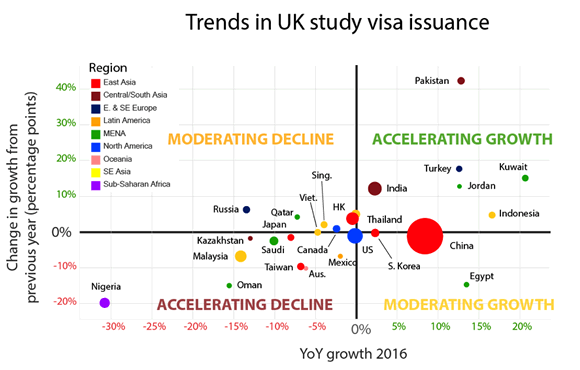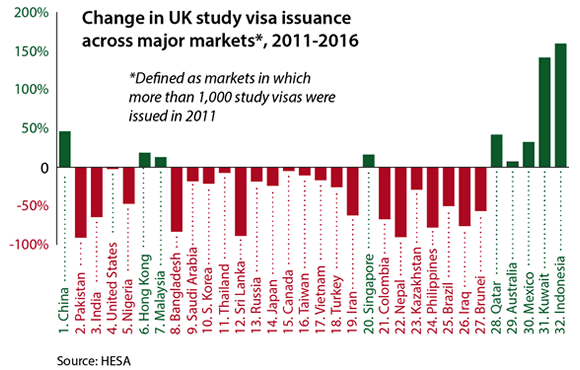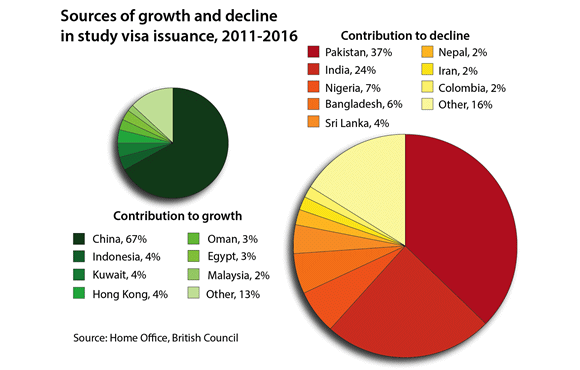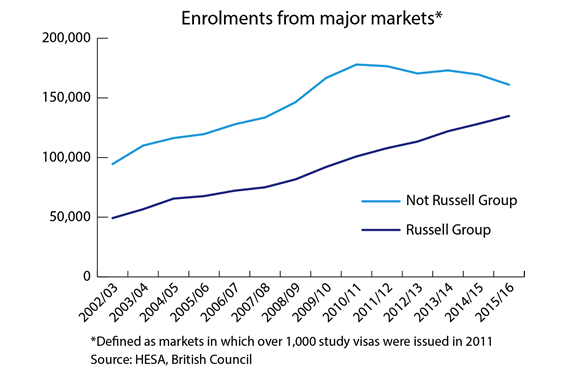UK study visa statistics from 2016 show that the number of major UK recruitment markets is dwindling and key markets are in jeopardy, with only continued growth from China preventing a substantial overall decline in student mobility to the UK.
At first glance, the headline figure doesn’t seem too alarming: the UK issued 194,608 study visas in 2016, down by 0.2 per cent from a year earlier. But the aggregate figure masks a worrying shift in the composition of the UK’s international student recruitment portfolio, with universities relying on a shrinking number of struggling markets.
In 2016 there were 26 markets in which more than 1,000 UK study visas were issued, down from 32 markets five years earlier, according to our analysis of Home Office data. These remaining 26 markets comprise the overwhelming majority of the UK’s non-EU student recruitment, accounting for 89 per cent of UK study visas issued globally. Yet the majority of them appear to be slipping: 17 of the 26 saw study visa issuance decline from the previous year.
As the chart below shows, Nigeria experienced the sharpest decline, with UK study visa issuance down by 30.7 per cent year on year from 2016, notably worse than the 11 per cent drop posted the previous year.
Malaysia, long one of the UK’s top recruitment markets, saw study visas recede by 14 per cent to 7,697. Despite shedding a combined 3,826 study visas from 2015, Malaysia and Nigeria still rank as the UK’s 5th and 6th largest non-EU recruitment markets, respectively.

Source: Home Office, British Council
Many of the markets experiencing sharp declines in study visa issuance are dependent on natural resource exports – oil income accounts for roughly a third of the Malaysian government’s revenue – and the downturn in global commodities has hurt both general economic conditions and government scholarship programmes.
Some relief may be on the horizon for these markets. The World Bank’s recent forecast says that commodity prices bottomed out in 2016 and are expected to begin recovery in 2017, with crude oil and metals prices forecast to rise by 29 per cent and 11 per cent, respectively. This is good news, but we are still far off the high price points that filled government coffers and allowed the expansion of scholarship schemes for study abroad. Commodity prices look set to continue in the low to moderate range for the foreseeable future, meaning that a broad recovery in student flows from resource-dependent markets is still years away.
More worrisome are the declines of East and Southeast Asian markets, such as Japan, Taiwan, Vietnam and Hong Kong, which are not linked to commodity market cycles. With the exception of Vietnam, these are mature markets where rebounds are unlikely and shrinking youth populations could drag outbound mobility numbers even lower.
Bright spots in the data include India and Pakistan, which returned to slight growth after a half decade of precipitous decline. India eked out 2 per cent year-on-year growth, or an increase of 245 study visas. Pakistan posted stronger year-on-year growth of 13 per cent. Yet rather than the beginnings of a significant recovery, this is more likely a sign that these markets have finally bottomed out under UK visa policy settings. A return to previous mobility levels is unlikely.
Several smaller markets have brighter outlooks. Indonesia sustained strong growth, with study visa issuance rising by 17 per cent year on year to 2,636. Kuwait, whose investment in study abroad scholarships has been unfettered by falling oil revenue, saw study visa issuance expand to 2,476, up by 21 per cent from the previous year. Turkey, Egypt and Jordan also continued steady growth.
In China, the linchpin of UK student recruitment, study visa growth slid to 8 per cent year on year, down from a 10 per cent expansion the previous year. Recent data from China shows that growth in the number of all outbound students slowed even more sharply in 2016. The unrelenting rise in China’s outbound students has kept the UK international sector afloat through tightened visa restrictions and a financial crisis. If the China market has finally found its ceiling, the business of international education will be markedly different going forward.
International recruitment: not what it used to be
For that matter, international education looks starkly different than it did just five years ago. In 2011 there were 32 markets in which the UK issued over 1,000 study visas. As shown in the chart below, 23 of the 32 major markets saw UK study visa issuance decline in the 2011-2016 period and 8 have since dropped below 1,000 study visas.

Looking at all 247 political units for which the Home Office tracks visa issuance, 38 per cent saw study visas rise in the 2011-2016 period. In total, these growth markets added 36,187 study visas, helping to offset the decline of 79,050 visas posted by the other markets. Yet this balance is even more precarious than it first appears, as China accounted for more than two-thirds of the absolute growth. If China’s outbound numbers crest – as they already appear to be – the scales could tip much more heavily towards an overall decline in UK recruitment.

Worse for some than others
While the data above look bleak, UK institutions have not felt the pain equally. A look at HESA enrolment data for the 32 major markets of 2011 shows a sharp contrast in the experience of Russell Group and non-Russell Group institutions over the subsequent five years. Enrolments in non-Russell Group universities receded after visa rules were tightened. The Russell Group’s share of enrolments from the 32 major markets meanwhile grew from 38 per cent in the 2011/12 school year to 46 per cent in 2015/16. The current trend suggests that the Russell Group’s share will continue to grow.

This is not to say that student recruitment is a lost cause for non-Russell Group universities, but the realities of UK visa policies and global economic conditions suggest that they will be swimming against a strengthening tide. Success will depend on differentiating their business approaches, shifting away from a focus on recruitment and looking at more diversified array of transnational education, foundation and professional development offerings.
This may seem like a burden in the short term, but it may put these universities on better footing for the future. The emerging trend in global higher education is a shift towards intra-regional student flows, particularly in emerging hubs in East Asia, Southeast Asia and the Middle East. Given limited options for expanding recruitment at home, many UK institutions will have to focus their efforts on delivering abroad. In the long-run, they may be thankful for the head start.
Matt Durnin
Regional Head of Research and Consultancy, East Asia | British Council
Matt.Durnin@britishcouncil.org.cn
